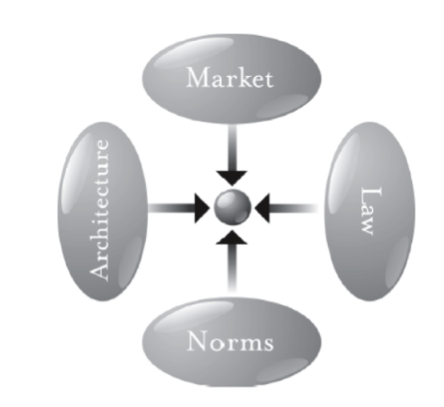With David Hondula

For over a decade in our classes we have taught Lawrence Lessig’s framework for thinking about how to regulate behavior in a system when multiple concurrent forces are at work. He illustrates his point by using the simple example of trying to regulate smoking. Market forces suggest that changes in the price of cigarettes should drive changes in use. Legal forces can restrict, punish, or even incentivize smokers for their behavior. Social norms , including peer pressure and popular culture, can quickly dissuade or encourage their use. Finally, the architecture of the space (the convenience of smoking locations) or the technology of cigarettes (the rise of vaping) also influences consumption. This framework has served us well and we have taught it in nearly all of our classes. At the same time, it seemed incomplete because it does not capture the influence of education campaigns or changes in the understanding of the consequences of smoking. This fifth category of influence could reasonably be considered an intervention through the use of information. As the information available to individuals and groups change, they should be able to better reflect their intentions.
The idea that informed individual choices lead to the emergence of collective efficiencies is hardly new. The Wealth of Nations and America’s Declaration of Independence are both predicated on a similar logic. Both understood people to be agents of independent judgment that when individually making the best choices for themselves, the emergent result was the best possible allocation of resources (capitalism) or the most reflective policy of the will of the people (democracy). An informed public has always been seen as central to realizing the potential self-governance but it has always been treated as an assumption, not as an intervention.
The use of information in the design of good governance infrastructures is increasingly important as data is viewed as a public good that can be used to serve a public purpose (see Johnston & Hansen, 2013). We will illustrate this with one trivial example (traffic) and then expand into a more detailed application of this approach (extreme heat).
Centrally regulating traffic can be a nearly impossible task. However, the technology now exists to give drivers near real-time information about current traffic conditions as well as the consequences of alternative routes on their commute time. This information allows for the self-regulation of which routes to take without falling back on the market, norms, policy, or architecture. A hidden, but important, advantage of this approach is when people are acting on their own accord, making informed decisions based on their own self-interests, it minimizes the adversarial aspects between people and their government.
Similarly, one of the essential functions of government is to protect public safety. Increasing attention is now being drawn to the public health impacts of natural hazards. Government agencies often play a central role in helping communities prepare for, respond to, and recover from events like tornadoes, floods, and snowstorms. The growth of the digital era, and all of its technological and computational affordances, make it possible for public agencies and other actors to employ information interventions in their efforts to protect communities when such hazards occur. Health advocates, from officials to nonprofits to individuals, are increasingly able to customize preparation and response efforts based on real-time data of an individual’s actual experience.
The strategic incorporation of a variety of data sets and streams can improve public health (and other) interventions concerning natural hazards. To discuss the prospects for data-driven, evidence-based public management of the risks associated with hazards, let us ground it with an example of Maricopa County, Arizona, the anchor of the hottest large metropolitan area in the United States. In this locale, a hazard of concern for public health agencies is extreme heat—one that kills more people each year in the United States than floods, hurricanes, tornados, and lightning combined (Berko et al. 2014). The growing availability of health and exposure data (e.g., from expanding environmental sensing networks, mobile applications supporting the quantified self movement, and citizen science efforts) and our ability to analyze and interpret these data in meaningful ways has the potential to transform the manner in which local agencies respond to the serious threat of extreme heat.
In the context of extreme heat, the choices of interest are the individual and collective behavior changes that reduce the risk of adverse health outcomes for people at risk. The societal policy decisions of interest are the plans and programs that agencies implement with the goal of limiting unwanted consequences. In central Arizona, these are reflected in the Extreme Heat Emergency Response Plan of the Arizona Department of Health Services (ADHS), the coordination and activation of the Phoenix Heat Relief Network of cooling centers and water distribution facilities by the City of Phoenix and the Maricopa Association of Governments, the operation of a seasonal heat-health surveillance program by the Maricopa County Department of Public Health (MCDPH) and the issuance of extreme heat warnings to the general public by the Phoenix forecast office of the National Weather Service (NWS).
Returning to Lessig’s framework shows both an open governance challenge and opportunity. The behavior that we are trying to regulate is exposure to extremely high temperatures (especially when combined with activities or circumstances that exacerbate risk, such as demanding physical activity). Market forces could subsidize air conditioning units to make them more ubiquitous, but they currently do not. Legal forces can restrict or punish people for being outdoors and/or engaging in dangerous activities on hot days, but they currently do not. Social norms can quickly dissuade or encourage outdoor behavior, but there is no evidence that there is a stigma for being outdoors when it is hot. The architecture of the spaces in which people reside, work, play, and travel (e.g., the design of individual buildings, neighborhoods, or cities, and the accessibility and availability of public cooling centers) or the technology of cooling people (e.g., air conditioned space, misters) can provide benefits, but only if sought out and deployed effectively. Thus many of the regulatory mechanisms envisioned by Lessig currently have limited applicability in the context of protecting people from extreme heat, which has motivated us to consider alternative mechanisms that can drive individual and collective behavioral change.
An intervention based on information enables the self-regulation of individuals to avoid extreme heat by using emerging sensor technologies. The ubiquity of smartphone technology and growing abundance of sensors embedded in societal infrastructure make it increasingly possible to collect data for which, previously, only crude regional estimates or models were available. In the context of extreme heat, the data of interest are the temperatures individuals experience and their resulting physiological state as they move throughout the urban landscape (see Kuras et al. 2015). In cases of overheating, one should minimize their exposure well before any physiological symptoms are noticeable. Certain smartphones are already able to alert users when they—the phones themselves—become too hot for safe operation of the internal hardware. But soon analogous technology could be available to alert phone owners when they—the people—were in danger far earlier than the appearance of physiological symptoms. It will soon be possible to use this information that could be streamed in real time, to communicate directly with those at risk or others who could intervene. The information improves the effectiveness of strategies for lowering risk ranging from better timing of taking breaks and drinking water to accessing nearby cooling and medical resources. Our pilot studies with personal ambient temperature sensors (e.g., Kuras and Hondula 2015) have suggested that generalized approaches to heat preparedness and response are not as efficient as the precision approaches possible with information interventions because many people experience heat differently on the same day.
Even as new potentials for using information to self-regulate behavior grows, we should remain cognizant of the potential disadvantages and tradeoffs associated with shifts toward data-driven approaches. We need to pay attention to how reliance on data might systematically advantage or disadvantage particular groups. Many of the resources for reducing adverse health outcomes associated with extreme heat are already in place but are underutilized by the populations most at risk. Through the advancement of technical systems and cultural practices that allow for the intentional use of information to occur, we envision that public agencies and the public at large will be able to more effectively leverage community resources and that governance entities will be able to improve their ability to perform their most essential functions while decreasing the intrusiveness on the public. Projections of future climate suggest that an increasing number of cities around the world will be looking to locales that already face chronically hot weather for best practices for coping with extreme heat. As academic researchers who share in the responsibility for the health and vitality of the communities of which we are a part, we will continue to experiment with opportunities for information to enhance the resiliency our communities and invite others to join in these efforts.
References
Lessig, Lawrence. 2006. Code Version 2.0. New York: Basic Books.

